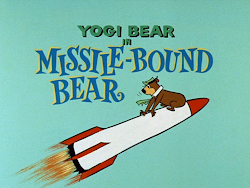Credits: Animation – Bill Keil, Layout –Tony Rivera, Backgrounds – Fernando Montealegre, Written by Warren Foster, Story Director – Paul Sommer, Titles – Art Goble, Production Supervision – Howard Hanson.
Voice Cast: Yogi Bear, General – Daws Butler; Boo Boo, Ranger Smith, Fired Soldier, Driver – Don Messick.
Music: Hoyt Curtin.
First Aired: 1961-62 season.
Plot: Yogi, Boo Boo and Ranger accidentally launch themselves into space.
Jay Ward cartoons were known for taking shots at things. Hanna-Barbera cartoons were not. This cartoon is about as satirical as Hanna-Barbera would get. The cracks at the U.S. military are the highlight of the cartoon. Not an awful lot else happens.
It opens with a general at a secret briefing in Washington, D.C., revealing how a rocket shot from Jellystone Park (a national park?!) will put a man in orbit for the first time. “We’re using an entirely new system of rocket launching,” says the general. “This new system is to launch the rocket first then talk about it. We’ve never done it this way before, but it’s worth a try.”
Yogi, Boo Boo and Ranger Smith end up in the rocket and accidentally make it lift off. A guard, who didn’t notice the three goes inside, watches the blast off. “Typical operation,” he says to the camera. “The enlisted man’s never told a thing.”
He reports the launch to the general. “The rocket? That is impossible. It would take hours to press the right buttons, pull the right switches, in the exact sequence. Even we don’t know how. That’s why we’ve been delayed.”
The three try to figure out how to get back to Earth. Boo Boo remembers reading about an escape hatch in a magazine article. Ranger Smith clasps his hands. “Thank goodness there are no military secrets in this country.”
The general fires the guard who reported the launch. The guard’s so delighted his helmet jumps off in excitement. “Fired?” From the Army? Mabel, baby’s coming home!” says the guard. So much for dedication for the serving the country.
The rest of the cartoon is the typical. It’s yet another cartoon where Yogi hibernates. It’s yet another cartoon where Boo Boo is “the good bear.” It’s another cartoon that ends with Ranger Smith promising Yogi a picnic basket if he won’t do something, in this case publicise the rocket launch (Yogi, ever the iconoclast, is willing to disobey the general’s “order” to keep quiet about it, while the uniformed, ex-military Smith is happy to comply). And it’s another cartoon that ends in a rhyme: “You’ve a lot of cheek, but when it comes to pic-a-nic baskets, I’m very, very weak,” says Yogi after the Ranger bribes him into silence with food. I do like the bit that Yogi is awoken from his sleep because Ranger Smith hadn’t finished singing the lullabye to him.
Let’s look at some background drawings.






The credits say Monte did the backgrounds for this cartoon. Monte’s stuff was much flatter in the earlier cartoons. The frame below has a tree with the fronds hanging down. Art Lozzi drew trees like that, so it’s possible he contributed some backgrounds. Lozzi once mentioned that the credits weren’t altogether accurate.

Bill Keil animates Yogi with a little line from the nose to the lip, with the head slightly turned.

Hoyt Curtin’s underscore is typical for 1961. For whatever reason, the ranger is humming Brahms’ Lullaby while one of Curtin’s tunes is playing. It clashes.





















































